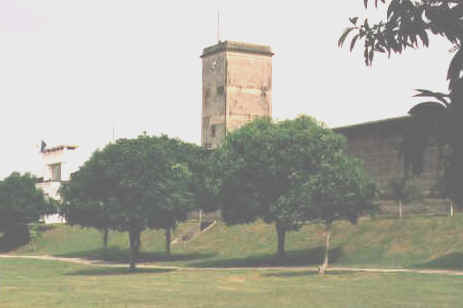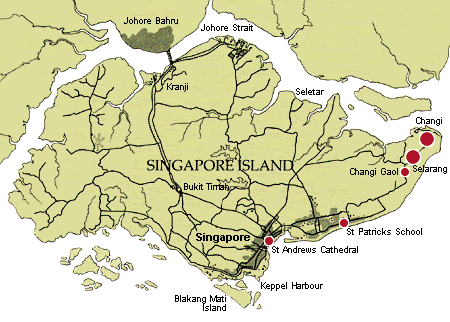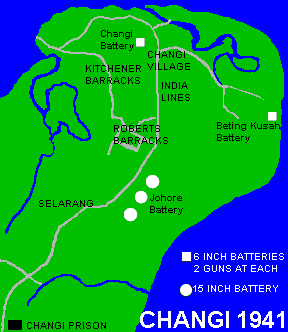 |
| Category: Battles/WW2 |

|
This page is a sub
category index |
|
|
|
|
Changi Prison: was it a "hell hole"? |

Changi
Maximum Security Prison, 1994. Contrary to the myth this is NOT where
most Australians spent the period of captivity in 1942/45.
They were actually mostly incarcerated
in Selarang Barracks, a former British Army base set on about 400 acres
of farm-land and rubber plantations.
Over 22,000 Australians became
prisoners of war of the Japanese in south-east Asia . The wave of
Japanese victories ending with the capture of the Netherlands East
Indies in March 1942 left in its wake a mass of Allied prisoners of war,
including many Australians. Most of the Australians (14,972) were
captured in Singapore ; other principal Australian prisoner-of-war
groups were captured in Java (2,736); Timor (1,137); Ambon (1,075); and
New Britain (1,049). |
Sub category index
|
- Over the years the story of the
dreadful treatment by the Japanese guards of Allied Prisoners of War
(POWs) has been told a thousand times. Unfortunately many myths have
grown up, particularly here in Australia. I make an attempt here to
provide the truth. It is awful enough without having anyone gild
the lily.
- First lets get a few things on
record before the enraged mob comes for me with the rope.
- I am NOT an apologist for the
Japanese or their treatment of POWs.
- I fully recognise the horror of
that time (as well as one can without living through it) and the
deep and lasting effect it had on the men and women concerned. I
do not try to downplay that at all. Each one who lived through
it and returned to lead a close to normal life is a hero in my
eyes.
- Those who died in captivity are
just as much to be respected on ANZAC Day as any other sailor,
soldier or airman who was killed in action.
- My desire is to see the truth told
so that when my grandson reads the "history" of WW2 and
comes to the part about Changi he will be dealing with fact, not
some urban myth that has grown up and gained a life and
respectability from constant retelling.
|
 "Changi
became known as the most notorious camp in Asia, and in the minds of
many people in England, Australia, and America, the Changi
prisoner-of-war camp would invoke visions of atrocities, starvation, bad
living conditions and emaciated men. It was the place where
prisoners-of-war were reduced to a physical state more looking like
living skeletons. As a prisoner-of-war, not only in the Changi Camp but
in various camps in Singapore and Siam [Thailand], I cannot understand
how Changi had earned such a reputation. My
memories of Changi have never been unpleasant.
"Changi
became known as the most notorious camp in Asia, and in the minds of
many people in England, Australia, and America, the Changi
prisoner-of-war camp would invoke visions of atrocities, starvation, bad
living conditions and emaciated men. It was the place where
prisoners-of-war were reduced to a physical state more looking like
living skeletons. As a prisoner-of-war, not only in the Changi Camp but
in various camps in Singapore and Siam [Thailand], I cannot understand
how Changi had earned such a reputation. My
memories of Changi have never been unpleasant.
Prisoners-of-war in Changi did
suffer deprivation and loss of self-esteem, but conditions
were not appalling. Although food
was rationed, it was provided every day. The camp was also provided with
amenities, such as electric lights and piped water, which contributed to
our cleanliness and good healthy conditions."
Lionel
De Rosario |
 |
Changi
is and was much more than a prison.
It is both a village and a locality
with an area of
thousands and thousands of acres.
What we, in Australia, might call a rural
suburb or village.
When the island
"fortress" of Singapore fell to
the Japanese in 1942 all the "captives" were sent to the area
of Changi, which became a huge POW Camp.
|
|
It was never just a prison in the normal European
sense of a group of concrete buildings surrounded
by a high concrete fence with guard towers.
Sheer numbers
would have made that impossible even if it had been the desire of the
Japanese. When Singapore fell there were 50,000 British, Dutch and Australian
troops sent to Changi in the first week.
| Three days later
General Percival accepted the Japanese surrender terms, and
within a matter of hours the enemy decreed that Changi should
become a gigantic prison camp, in which all the British captives
would be concentrated. The order for all troops to move to
Changi was given on 16th February, and from then until 18th
February a procession of over 50,000 prisoners trudged wearily
along the long winding road leading eastwards from the
city Extract
from Changi
History by Sqn Ldr H A Probert |
Most of the POWs were housed in
former British Army barracks. The
Australians were housed mostly in Selarang Barracks. It is made up of 8 major buildings, a dozen or more
minor buildings and 400 acres of land. It had been home to the 2nd
Battalion Gordon Highlanders. In the 1970's it was home to the
Australian Battalions that formed part of ANZUK, 1 RAR and later, 6 RAR.
The British and Dutch were housed at
Roberts Barracks, Kitchener Barracks and the wooden barracks at India
Lines. Part of Roberts Barracks was used as the hospital.

Over the years many myths have
grown up, particularly in Australia, about the 'hell hole' of Changi
Prison. This site seeks to present the facts. THE FACTS ARE BAD
ENOUGH. To embellish them is counter-productive, and silly.
What is worse we now have
South East Asian tourist operators providing "re-creations" of
what we expect to see even though it may not be true Details
|
| Australian
prisoners of war. Second World War. Prisoners of the Japanese |
From the AWM
Encyclopedia
Over 22,000 Australians became
prisoners of war of the Japanese in south-east Asia . The wave of
Japanese victories ending with the capture of the Netherlands East
Indies in March 1942 left in its wake a mass of Allied prisoners of war,
including many Australians. Most of the Australians (14,972) were
captured in Singapore ; other principal Australian prisoner-of-war
groups were captured in Java (2,736); Timor (1,137); Ambon (1,075); and
New Britain (1,049).
At the end of the war Australian
prisoners of war were widely distributed: 5,549 on Singapore Island and
in Johore (Malaya); 4,830 in Burma and Thailand; 265 in French-Indo
China; 385 on Java; 243 on Sumatra; 100 on Ambon; 2 on Macassar; 7 on
Bali; 150 at Kuching (British North Borneo); 2,700 distributed between
Japan, Korea, and Manchuria; and 200 on Hainan Island. |
| Dates
when various prisoner-of-war forces left Changi Singapore , and their
destinations |
| Force |
Date departure from Changi |
Destination |
|
A Force
|
15 May 1942
|
Burma
|
|
B Force
|
8 July 1942
|
Borneo
|
|
C Force
|
28 Nov 1942
|
Japan
|
|
D Force
|
14-18 March 1942
|
Thailand
|
|
E Force
|
29 May 1943
|
Borneo
|
|
F Force
|
April 1942
|
Thailand
|
|
G Force
|
26 April 1943
|
Japan
|
|
H Force
|
May 1943
|
Thailand
|
|
J Force
|
16 May 1943
|
Japan
|
|
K Force
|
June 1943
|
Thailand
|
|
L Force
|
23 August 1943
|
Thailand
|
|
Senior Officers’ Party
|
16 August 1942
|
Japan via Formosa and Korea
|
|
Senior Working Party
|
16 August 1942
|
Takeo (Formosa) and Seoul (Korea)
|
| AIF units were split up
between various forces and work parties. The prisoners of war reading
list contains battalion unit histories which cover this topic. |
 from
the AWM site. from
the AWM site.
Changi
The name “Changi” is synonymous
with the suffering of Australian prisoners of the Japanese during the
Second World War. This is ironic, since for most of the war in the
Pacific Changi was in reality one of the most benign of the Japanese
prisoner-of-war camps; its privations were relatively minor compared to
those of others, particularly those on the Burma–Thailand railway.
For much of its existence Changi was
not one camp, but rather a collection of up to seven prisoner-of-war
(POW) and internee camps, occupying an area of approximately 25 square
kilometres. Its name came from the peninsula on which it stood, at the
east end of Singapore Island. Prior to the war, the Changi Peninsula had
been the British Army’s principal base area in Singapore. As a result
the site boasted an extensive and well-constructed military
infrastructure, including three major barracks – Selarang, Roberts and
Kitchener – as well as many other smaller camps. Singapore ’s
civilian prison, Changi Gaol, was also on the peninsula.
Most of the Australians captured in
Singapore were moved into Changi on 17 February 1942. They occupied
Selarang Barracks, which remained the AIF Camp at Changi until June
1944. For many, Selarang was just a transit stop as before long working
parties were being dispatched to other camps in Singapore and Malaya.
Initially, prisoners at Changi were free to roam throughout the area,
but in early March 1942 fences were constructed around the individual
camps and movement between them was restricted. In August, all officers
above the rank of colonel were moved to Formosa (present-day Taiwan),
leaving the Australians in Changi under the command of Lieutenant
Colonel Frederick “Black Jack” Galleghan.
Security was further tightened
following the arrival of dedicated Japanese POW staff at the end of
August 1942. The new Japanese commandant requested that all prisoners
sign a statement declaring that they would not attempt escape. The
prisoners refused en masse, and on 2 September all 15,400 Australian and
British prisoners in the Changi area were confined in the Selarang
Barracks area. After three days, a compromise was reached: the Japanese
ordered the declaration be signed, thus making it clear that the
prisoners were acting under duress, and the prisoners were returned to
their original areas.
Throughout the war, the prisoners in
Changi remained largely responsible for their own day-to-day
administration. The main contact with the Japanese was at senior-officer
level, or on work parties outside the camps. Extensive gardens were
established, concert parties mounted regular productions, and a
reasonably well-equipped camp hospital operated in Roberts Barracks.
Damaged infrastructure was progressively restored and both running water
and electric lighting were common throughout the Changi area by
mid-1943. Camp rations and supplies were supplemented by the
opportunities which work parties provided for both theft and trade. For
a time a university was operated inside the AIF camp but, like most
prisoner projects in Changi, it suffered after May 1942 when large work
parties began to be sent out of Changi to work on projects including the
Burma–Thailand railway. In February 1942 there were around 15,000
Australians in Changi; by mid-1943 less than 2,500 remained.
In May 1944, all the Allied prisoners
in Changi, now including 5,000 Australians, were concentrated in the
immediate environs of Changi Gaol, which up until this time had been
used to detain civilian internees. In this area 11,700 prisoners were
crammed into less than a quarter of a square kilometre, and this period
underlies Changi’s place in popular memory. Rations were cut, camp
life was increasingly restricted, and in July the authority of Allied
senior officers over their troops was revoked. Changi was liberated by
troops of the 5th Indian Division on 5 September, and within a week
troops were being repatriated.
After the war, Changi Gaol once again
became a civilian prison, while the Changi military area was repaired
and redeveloped for use by the British garrison. Following the
withdrawal of British troops in 1971, the area was taken over by the
Singapore Armed Forces and still has one of the main concentrations of
military facilities on the island. Roberts Barracks remains in use, but
the original buildings at Selarang were demolished in the 1980s.
Changi
Gaol is scheduled for demolition in the second half of 2004, although
the original entrance gate and a section of the outer wall will be
preserved as a memorial. A museum and a replica of one of the chapels
built by Allied prisoners in the Changi area have been opened on the
road between Changi Gaol and Selarang Barracks. In 1988 one of the
original prisoner-of-war chapels was transported to Australia,
re-erected in the grounds of the Royal Military College, Duntroon, and
dedicated as the national memorial to Australian prisoners of war. |
| Nothing
can justify the brutality of the Imperial Japanese Army on the
Thailand-Burma railway. However it might be wise to remind ourselves
that in the infamous Andersonville Prison operated by the Confederate
States of America during the American Civil War 12,912 of the 45,613
Union prisoners died during its fourteen months of operation. The death
rates in the concentration camps operated by the British Army in South
Africa during the Boer War were just as horrendous and they were mostly
women & children. Inhumanity and brutality are not restricted to
WW2. |
|